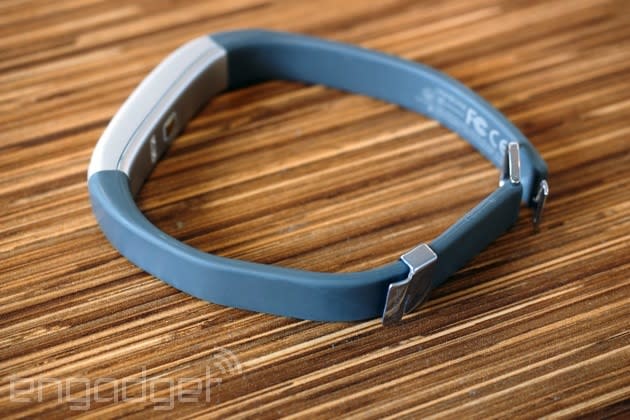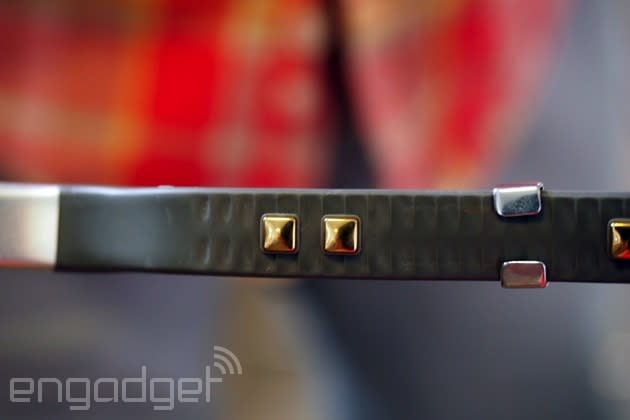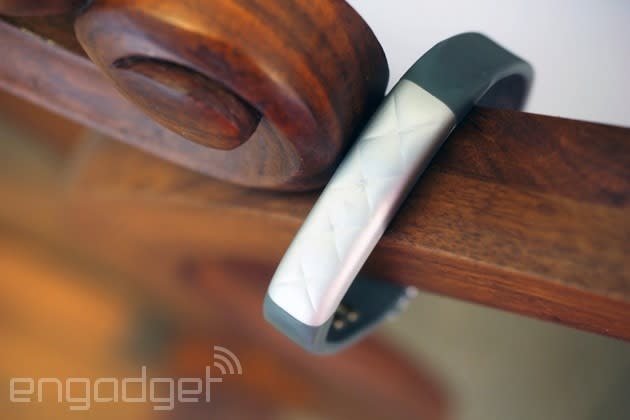Jawbone Up3 review: a feature-packed disappointment

Is there room for a $180 health band today that doesn't have a built-in display and is totally reliant on your smartphone? Jawbone's pitch for the Up3, its latest wrist-worn health tracker, is pretty much the same as its last few models. It's artfully crafted from the genius design mind of Yves Béhar, the company's chief creative officer. And it's packed full of sensors to track your every movement (this time it can even detect your heart rate!). But it's the middle of 2015 -- the Apple Watch is out; Android Wear is getting steadily better; and there are a slew of other fitness trackers on the market. Jawbone is also coming off of a lengthy delay that squashed what little momentum it had after the Up3's announcement. So, is the Up3 worth the hefty cost, even when it's facing much stiffer competition than ever before? Probably not -- especially after Jawbone just announced the $99 Up2, which has most of the features and design elements from the Up3 that really matter.
Hardware

The first thing you'll notice about the Up3 is that it doesn't look like one of Jawbone's Up health bands at all. Whereas the company previously went for a clamped bracelet design, which helped the Up lineup stand out against their typically clunky competitors, now it's a lot more watch-like. One big change is its adjustable strap, a big improvement from when you had to choose between three different sizes of Up bands. Jawbone's also moved all of the Up3's electronics to the top of the device, right under a new touch-control surface. You can double-tap the top of the device to switch between sleep and activity modes, while three LEDs let you know which mode you're in (or if you should check the Up app for notifications). And no, there's no display beyond those LEDs -- if you want to know how many steps you've taken, you need to open the Up app.
By moving the bulk of its electronics to a single location, Jawbone managed to make the Up's bands far more flexible. The company claims that should also help with reliability -- the electronics in the previous Up's arms often led to issues. Reliability was also the main reason Jawbone ended up delaying the Up3 for nearly six months. While it initially planned for the band to be completely waterproof, testing revealed that making something consistently waterproof was pretty tough. So for the Up3, it's going with the less certain "water-resistant" label.
It should be able to survive a shower or a strenuous dishwashing session, but don't expect to go swimming with the Up3. Jawbone's understandably weary of over-promising -- after all, it was forced to recall the entire run of its original Up band, as well as give refunds to everyone who bought one.

Under the hood, Jawbone stepped up its sensor game for the Up3. It can track your steps, naturally, but it's also smart enough to detect when you may be moving about. If you decide to take a walk in the afternoon, for example, the Up app will prompt you afterward to confirm that, alongside an estimated length of your workout. It still requires some work on your part, but the Up3 should make it easier to log activities than Jawbone's previous trackers. The additional sensors also allow for far more complex sleep tracking -- now it can detect your REM, light and deep sleep cycles.
The Up3 is also Jawbone's first device to include a heart rate sensor. And, as is usually the case with Jawbone, it had to do things a bit differently than everyone else. It's mainly focused on tracking your resting heart rate, which is typically measured right before you wake up, before you face the stresses of the day. That's pretty much the opposite of other trackers like Fitbit's Surge, which can read your heart rate in the middle of a workout. Knowing your resting heart rate could be a decent indication if you're too stressed out, and it might even give you an early warning that you're about to be sick. But, to be honest, there's not much beyond those vague hints that you'll get from knowing it.
And therein lies Jawbone's biggest problem with the Up3: What should be its most compelling feature is, in the end, a bit of a dud. Jawbone says it's working on bringing active heart-rate measuring to the Up3 eventually, but even if it makes good on that claim, you'll still be stuck fiddling with the Up app on your phone since it doesn't have a display of its own.
In use

My relationship with the Up3 was contentious from the start. To make it fit on your wrist, you've got to move a latch alongside one of its arms so that the hook-like end of its other arm slides in. Ideally, you'll want a tight fit, as being too loose can render its precious sensors useless. It took me nearly 10 minutes to figure out the best way to wear the Up3, and even after using it for a few weeks it still sometimes takes longer than I'd like to put it on. To make things even worse, the Up3 can easily come off if something hits your wrist in just the right way. That's never happened to me before with previous Up bands.
And while its new design is more functional, I have to say I miss the old Up's look. It had plenty of character, resembling a piece of digital jewelry more than a boring, old health tracker. It was something that even complete strangers complimented me on as I strolled around NYC -- that never happened with the Up3. But while it has less of a wow factor, the Up3 is noticeably more comfortable to wear all day due to it being much thinner and lighter than its predecessors. I never felt fatigued having it on my wrist, which has so far felt par for the course with health trackers.
Once I actually got it on, I had to learn the intricacies of the Up3's touch interface. Previous Jawbone bands relied on a single button to switch between sleep and active modes. With the Up3, you have to double-tap the touch sensor and hold down to switch between modes. That sounds simple enough, but the double-tap gesture doesn't work consistently. Sometimes it works the first time; sometimes it takes three or four attempts. Eventually, I just started hammering the touch sensor until I got some sort of response from the Up3. I grew to miss the tactile feedback of the old Up's mechanical button (even though that ended up breaking frequently).

When it comes to tracking your activity and sleep, the Up3 feels pretty consistent with Jawbone's past efforts. Step tracking is nothing to write home about these days, but I grew to appreciate its ability to automatically detect when I was active. If I went out for a quick run or bike ride, I didn't have to log those manually in the Up app. Instead, the Up3 sends a notification to your phone asking if you were active during a particular time. That feature wasn't always accurate, though -- it often classified my short walk and subway ride to the office as a workout session.
While detailed sleep analytics are a nice thing to have, they didn't change my habits much. I already know I need to sleep earlier -- tell me something new, Jawbone! The Up3's sleep tracking works best when you manually enable and disable it before and after you go to bed. But if you forgot to do that, it can also recover the basic details of your sleep after the fact (you lose out on some of the deeper analysis if you rely on the automatic sleep tracking, though). It also offers a smart alarm, one of my favorite features from previous bands, which wakes you up at the best possible moment during a specific time period. If you've ever woken up extra groggy, even after getting eight hours of sleep, it was probably because you were yanked out of deep sleep. The smart alarm here avoids that, but it didn't feel much more accurate than the Up24.
Similarly, Jawbone's focus on resting heart rate wasn't that useful. The Up3 typically read my heart rate around 70bpm, and it followed that up with some helpful links pointing out that's a healthy reading. But beyond that, there wasn't much I could do with that figure. I did notice my resting heart rate spike to 90bpm right before I got sick while traveling, but that was also a day when I woke up feeling ill. The Up3 didn't tell me anything I didn't already know.
Once again, you'll have to rely on Jawbone's Up mobile app to check on your activity, sleep and just about anything else related to the Up3. It wirelessly syncs to the band over Bluetooth, even when the app is running in the background. Not much has changed over the years -- the Up app still centers on a home screen that shows your current steps and the previous night's sleep -- but now your resting heart rate is also front and center. It also dishes out custom advice based on your performance, casually reminding you of the benefits of things like a full night's sleep, or taking regular activity breaks, if it notices you're being lazy.
It's a well-designed app, although it's still occasionally frustrating. When I tried to fix an automatic sleep entry that I mistakenly timed incorrectly (giving me a whopping 30 hours of snoozing), the app threw several errors. Even when I thought I corrected the information, the absurd amount of sleep clocked in never changed. I ended up just deleting that entry.
Why is Jawbone so averse to putting screens on its wristbands? Basically, it's all about battery life. For most devices, the screen ends up being one of the big power hogs. So Jawbone figured it was better to give people a longer-lasting device than one where you can see your steps instantly. The company estimates the Up3 should last around seven days on a single charge, which is pretty much what I saw after using it for a few weeks. But while I can understand Jawbone's devotion to long battery life, I'd much rather give up a few days of charge for a usable screen.
The competition

Somewhat ironically, the Up3's biggest competitor is Jawbone's other new band, the $99 Up2, which was announced just a few weeks ago. That cheaper model is basically just last year's Up24 with the Up3's design upgrades. But at nearly half the price, it really makes you question if the Up3's semi-useful heart-rate monitoring and advanced sleep analytics are really worth it. Personally, I think not. Jawbone would have been better off debuting the Up2 last fall and kept working on the Up3 until it had a more fully baked product.
And if you've got no problem spending nearly $200 for a fitness tracker, you've got a lot of other options like the Fitbit Surge ($250) and the Basis Peak ($200), both of which have continuous heart-rate monitoring and built-in screens that can display notifications. Double your price range and you can even snap up an Apple Watch Sport ($349), which can do a heckuva lot more than a typical fitness tracker.
Wrap-up

In the end, it's easy to be disappointed by the Up3. Even after its long delay and the omission of waterproofing, it still had the potential to be a different sort of fitness tracker. Unfortunately, it offers only minor improvements over Jawbone's last model. And the few new features aren't very useful at all, especially when compared to what others offer in its near-$200 price range.




















